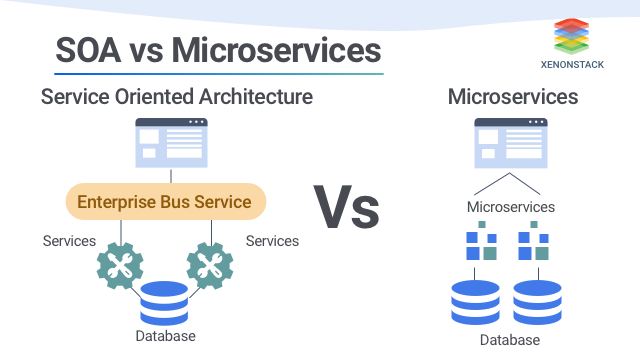
Introduction to SOA and Microservices
Service-Oriented Architecture vs Microservices is now becoming the top priority for a significant group of developers as these architectures help them in developing applications that are independently deployable and consist of a set of dissociated services. With the increasing need for better performance and scalability of applications, the older architectures are becoming obsolete at a fast rate. They have both similarities and differences; here, we are going to understand their concepts and their differences.What is the Service-Oriented Architecture?
It is a software designing style or architecture in which communication protocols are used by the application components to provide services to other components. It is a collection of services communicating with each other. In this individual services are organized around a particular business process and adhere to a communication protocol (like SOAP, ActiveMQ, or Apache Thrift) to share themselves through the ESBWhat are the Microservice Architecture?
Popularly known as Microservice Architecture, these are software development techniques. It came into existence as an alternative to traditional development techniques. It structures the software/application into a collection of finely-grained services. These services are loosely coupled and self-contained. The unit/part of software which performs some specific work or task is known as Service, Some of the services in Service-oriented architecture and Microservices architecture are:An approach for developing small services each running in its process. It enables the continuous delivery/deployment of large, complex applications. Click to explore about our, Application Architecture for Digital Transformation
What are the services in SOA?
The services in Service Oriented Architecture can be divided into four categories- Infrastructure Services: These are the services that implement some non-functional tasks like logging, authentication, and security. These can further be divided into the following categories:
- Communication services: These services are concerned with message transportation.
- Utility services: This provide other technical capabilities like reusable functions, event logging, notification etc. but not the transfer/transportation of messages.
- Business Services: These are services required to perform some business functions. These can also be named as Application services. It has these categories under it:
- Activity Services: Provide specific business capabilities.
- Process Services: They contain business logic.
- Entity Services: Work to show/expose information stored in backend databases.
- Capability Services: Provide general business capabilities.
- Application Services: These are the services that provide a dedicated user interface to invoke other services. They are limited to the context of some specific applications.
- Enterprise Services: They do the work of implementing the functionality, which is defined by the business services. They need the help of infrastructure services and application services to complete the business requests.
Benefits of Service-Oriented Architecture
- Improved flexibility and information flow.
- Significant amounts decrease the development cost and management costs.
- Data confidentiality is improved.
- New function combination developing ability and speed is increased.
- Better reliability.
- The system upgrades are readily available and introduced quickly.
- Manageability and security are improved.
- The defects are decreased, and the testing is improved.
Contract Testing in the Microservice architecture is about splitting the application into small standalone services. Click to explore about our, Contract Testing for Applications with Microservices
What are the services in Microservices?
Microservices are divided into two major categories of services, which are :- Infrastructure Services: These services perform tasks like security, logging, and auditing.
- Functional Services: These services help in performing business functions for specific operations and services. The services are accessed externally and are not shared with any other services.
Benefits of Microservices
- Speed and productivity are increased as it decomposes the applications/software into faster developing and manageable services.
- The microservice architecture is flexible with technologies, and different services that are written in different languages can run together.
- The microservice is easily deployable.
- It is easier to change, enhance, and test.
- The services are independent and have no or meager impact on other co-existing services.
Digital Business Transformation is the application of technology to build new business models, processes, software and systems. Click to explore about our, Application Architecture for Digital Transformation
Service-Oriented Architecture vs Microservices Architecture
Service-Oriented Architecture and Microservices/Microservice architecture have a lot of standard utilities, but they also have a lot of differences, which are described as follows:- Size Difference: The size difference is based on the granularity of the components inside the architectures. The components or services in Microservice architecture are comparably much smaller and lighter than that of Service-oriented architecture. Its components/services are not that detailed and are less finely grained, that is why it has less number of components available, but are comparably bigger.
- Scope Difference: It includes loads of business features and functionality and is used as a complete subsystem most of the time, while it perform the single task that they are designed to perform.
- Data Storage Difference: The services in Service Oriented Architecture share common data storage most of the time. In the case of it, there can be an independent data storage section for each service. The services can access their independent storage service when they need to.
- Development Dependency: Both Service Oriented Architecture and Microservices are built to be managed by several teams, but in the case of Service Oriented Architecture, the communication mechanism needs to be common for all teams. While in Microservices, each team can work on distinct service that can be developed and deployed without the interference of other services
- Remote Accessing Protocols: It use Simple Object Access Protocol (SOAP) or messaging mostly for remote access, while Microservice architecture relies mostly on REST and sometimes does the work through simple messaging such as MSMQ.
- The sharing of components: Here is where the concept of ‘bounded context’ comes into the light, which is used by it to decrease or minimize the sharing of components. In the case of Service Oriented Architecture, the sharing of components is enhanced and is a common approach. Because of multiple services sharing the components, the systems are comparatively slower in the case of Service-Oriented Architectures.
- API layer vs. Messaging middleware: Service Oriented Architecture has a component named messaging middleware, while Microservice architecture uses the API layer. The messaging middleware has some benefits over the API layer, such as enhancement of message, protocol transformation, and routing. The API layer is present between service consumers and service in the case of Microservice architecture.
The fusion of digital technology into all industry sides, changing how you use and convey it to customers. Download to explore the potential of Digital Transformation
Conclusion
Even based on these differences in Service-Oriented Architecture vs Microservices, there is no method in which one is better because both of them have their benefits and issues. It can be a better option to build complicated and broad application environments related to business, and it can be suitable for small systems or web-based systems. Thus the debate of Service-Oriented Architecture vs Microservices can conclude with the purpose of the application decides the architecture.- Discover here about Microservices Architecture Design and Best Practices
- Read more about Guide to Service-Oriented Architecture (SOA)


